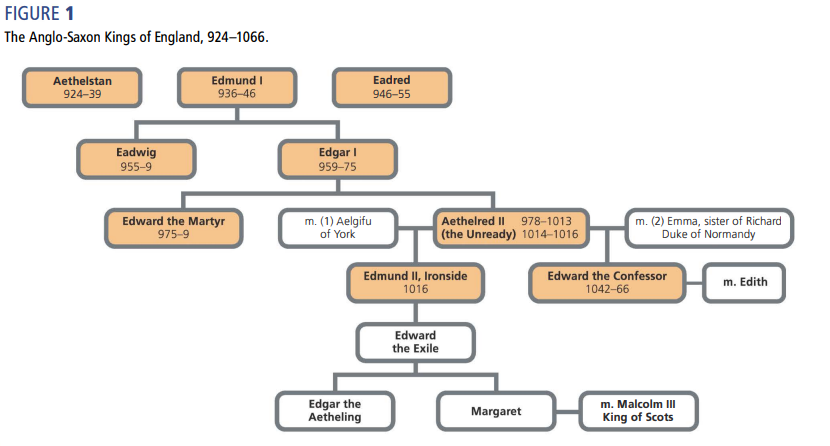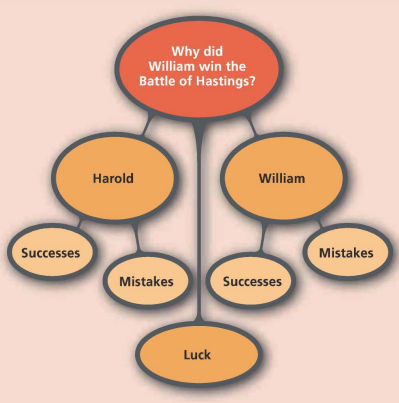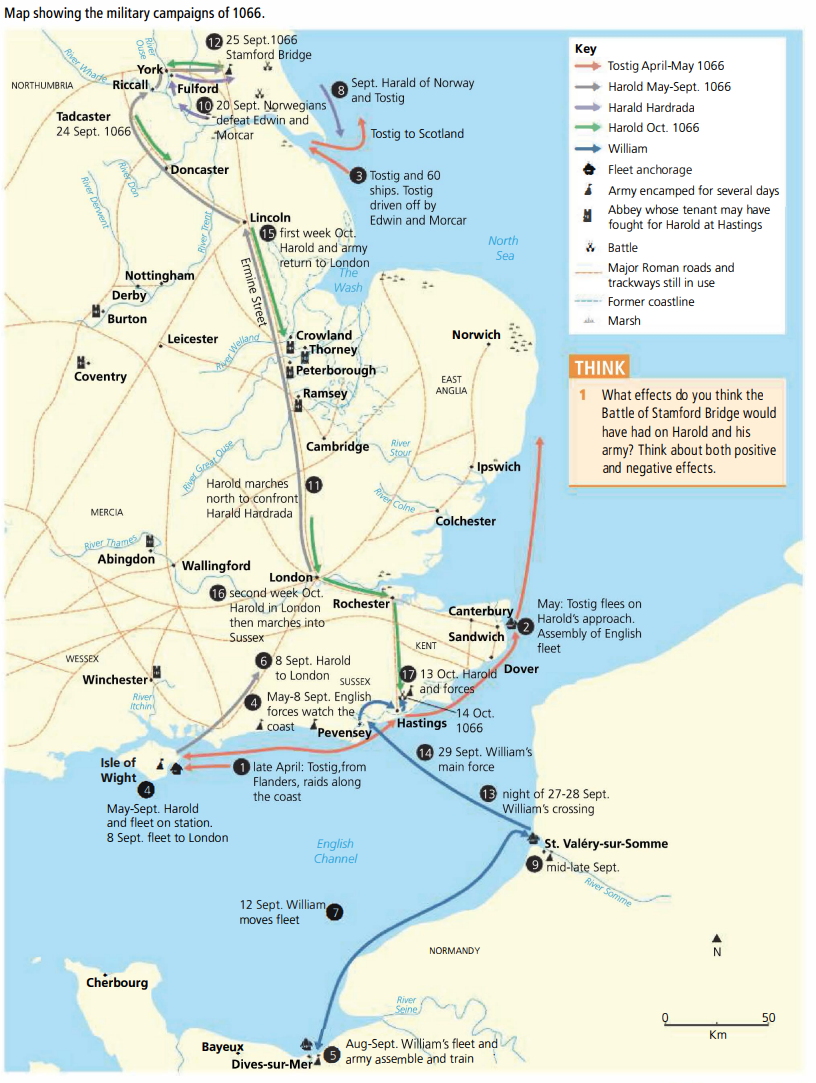Chapter 1: The Normans - Conquest and Control
The Succession crisis in 1066
From Vikings to Edward
A Wealthy Country
- England had rich mineral resources and fertile faming land - farmers produced wheat, rye, barley and oats along with animal products.
- Wool trade was thriving - the cloth was highly valued in Europe.
- Christian country
- English towns = good source of taxes as efficient administration = attractive for invaders.
The Viking Connection
- 10th century - England faced constant Viking raids
- The English’s plan was to pay the Vikings to leave - these payments were called Danegeld. However every year the Vikings would come back for more.
- The raids increased until 1013 when the Vikings began a full scale invasion and the English King Aethelred was defeated and killed by Canute in October 1016.
- Canute then murdered most of Aethelred’s family - despite this England was relatively peaceful and prosperous under Canute’s rule for the next 20 years.
The Norman Connection
- Aethelred’s widow, Emma and his two surviving sons escaped to Normandy where they were protected by their uncle, Richard the duke of Normandy.
- Richard raised the sons in the Norman court but forced Emma to return to England and marry Canute - this was to make sure the Normans had some influence in England.
- This also was good for Canute because marrying the old King’s widow made him seem more English.
The English Earldoms
- England was only a small part of the empire ruled by Canute.
- To make sure the country was effectively controlled while he was away he divided England into 4 earldoms: Wessex, Northumbria, Mercia and East Anglia.
- The earls became the next most powerful men in the country and the earl of Wessex (Earl Godwin) the most powerful of the four.
Edward’s Path to the Throne
- When Canute died it was unclear who should rule next - the idea of the eldest son being the heir didn’t apply then.
- Two of Canute’s sons each had short reigns - Harefoot died in 1040 and his brother Harthacanute became an unpopular king
- In 1014 Harthacanute invited Edward to England - He ascended to the throne of England in June 1042 when Harthacanute died suddenly while drinking at a wedding feast.
- The Vikings were losing interest in England and their empire was under attack by the Scandinavians.
- Edward was officially crowned king on the 3rd of April 1043
- In 1045 Edward married Earl Godwin’s daughter Edith - this secured the support of the most powerful English earl.
Edward the Confessor and the Godwin Family
- Relations between the Godwins and Edward were tense despite marriage - In 1051 the Godwins repelled but they were exiled by Edward and the Earls of Northumbria and Mercia. Edward appointed more Normans in his court in response.
- The English advisers, the Witan resented this and encouraged Godwin and his army to come back to England who forced Edward to expel Norman advisors and restore Godwin to his to his previous position.
- Edward turned out to be a weak ruler, taking less interest in governing England and preferring to focus on religion - he built Westminster Abbey.

Harold Godwinson: The Home-Grown Strongman
- Harold Godwinson was not a blood relation of Edward but his brother-in-law.
- For years the Godwins were the most powerful family in England - they tried , but failed to overthrow Edward in 1051. Due to this they were exiled, but allowed to come back a year later
- In 1053 Harold inherited his father’s earldom, making him the richest man in England.
- Apparently Edward’s dying wish was for Harold to become king of England though William disagreed saying Harold had sworn a scared oath of allegiance to support William to claim the throne. However Harold denied this saying he had been threated and the oath wasn't binding.
An Uneasy King
- Edward the confessor died on the 5th of January 1066 - the next day Harold was crowned King of England.
- Harold was popular with the English lords and was soon to be married to Ealdgyth - the sister of the powerful Earls Edwin and Morcar.
- Harold , despite being a respected warrior and very wealthy man, he knew he would face challenges on the throne. That’s why he was so hasty to get crowned as king.
- One main issue he face was that Harold’s rivals for the throne were still there across the sea in Normandy and Norway.
Why did William win the Battle of Hastings?

Harold knew he would have to defend his throne and from the start of his reign he started preparing.
- Harold expected an invasion from Normandy so assembled a navy, but he didn’t have any boats so he demanded boats from seamen around the country who complied.
- He also assembled an army, however even in those days the King wouldn’t keep a standing army, when he would need to fight, he would call upon the housecarls, thegns and fyrd (professional soldiers, lords and ordinary people).
Harold had all his troops stationed on the south coast of England waiting for William - however it was not William who came but Harold’s brother Tostig.
The Tostig Interlude
- Tostig had been removed from his position as Earl of Northumbria in 1065 and was sent to exile in Flanders. However he convinced Harald Hardrada that he should come back to England and seize the crown from Harold.
- In may 1066 Tostig started his campaign, his ships and soldiers raid towns along the Sussex coast
- Tostig occupied the town of Sandwich for a while but the threat of Harold’s army scared him off.
- Tostig went north then some raids in Lincolnshire before Earls Edwin and Morcar made him flee to Scotland where he waited for Hardrada.
May to September - William’s Preparations
- William’s preparations were slower but mostly because they were more thorough.
- Some Normans thought it was an risky enterprise - which it was but William was confident and persuaded others it could be successful.
- He even got the support of the Pope who gave him a Papal Banner to carry into battle it meant that God was on their side.
- William had no army, instead he had to call on his lords to bring themselves and their knights from Normandy and beyond.
- He also didn’t have a navy, so he had to ask his vassals to provide some ships - they couldn't’ provide enough so he ordered hundreds of ships to be built.
- To secure his position once he was in England, William pre-fabricated castles to take to England (like IKEA furniture so all you have to do is assemble it and not measure wood etc).
- While Harold was waiting for three months on the Sussex coast, William’s invasion force was gradually being assembled then trained.
- By August, William had 7,000 soldiers (including cavalry and archers) with up to 3,000 horses and around 700 ships, all training and preparing to invade England.
September 8th - Harold’s Army goes Home
- Harold had a problem - you cannot keep an army of 6,000 men together forever.
- The 3 month wait had exhausted resources, the soldiers needed paying and feeding, along with this, many of the soldiers were ordinary men who needed to get back to their villages to bring in the harvest.
- On September 8th, Harold sent his soldiers home and he went to London.
- This was poor timing as a few days later William moved his entire fleet to Saint Valery to await favourable wind to cross the channel.
- At the same time Tostig and Harald Hardrada were sailing down the north east coast from Scotland with a fleet of 300 ships and up to 8000 soldiers to prepare to invade the north of England.
Early September- The return of the Vikings
- Hardrada joined Tostig at the River Tyne and they landed at Riccall, near York.
- Hardrada’s claim to the throne was weak but he was a fierce warrior.
- On the 20th of September, During the Battle of Fulford, Earls Edwin and Morcar were defeated, but not killed - York surrendered to Hardrada.
Mid-September- Harold marches North
- When Harold learned of Hardrada’s arrival he re-gathered his army and marched north - his men covered nearly 200 miles in under a week.
- They were so quick that they caught Hardrada and Tostig by surprise at Stamford Bridge on the 25th of September - the fighting was fierce and lasted most of the day.
- Harold’s men won and Hardrada, Tostig and most of the Norwegian army died.
- Harold’s victory was short lived as within three days he received news that William had landed in England.

The Norman Landing
- Bad weather had delayed William’s invasion plans but the weather cleared and he set sail around the 27th of September landing at Pevensey the following morning whilst Harold’s army was still in the north.
- Pevensey was a good choice because the Roman fort offered some protection and it was a safe bat to land his army and supplies. The Normans quickly built their first castle and began terrorising the local population.
Harold’s Reaction
- As soon as Harold heard of William’s invasion he travelled to London and his mounted soldiers with him - they covered 200 miles in 4-5 days. He likely gathered a new army of foot soldiers in London
- Harold wanted to fight close to London however William wanted to fight near Pevensey.
- If Harold could not tempt William north then he would surprise William the same way he surprised Hardrada. This victory likely made Harold over confident.
The Battle of Hastings - 14th October 1066
Harold neared Hastings on the 13th of October but knew there was no chance of surprising William. William expected an attack during the night however Harold paused and camped overnight near Senlac Hill due to his army’s exhaust. In the early morning of October 14th, William went to find Harold’s army and when he found them at Senlac Hill the two sides prepared for battle.
Formations
- Both sides were evenly matched numerically with both having around 7-7,000 troops. But there were some key differences in how they were armed and positioned.
- The English seized the hill top and the housecarls formed their customary shield wall. Behind it were the fyrd who carried simple weapons like iron-studded clubs. The fyrd were led by the thegns armed with swords and javelins - Harold had no archers and only used horses to transport troops and equipment.
- By contrast William had heavily armed cavalry who fought in units of 5 to 10. The speed and power of horses charging could be devastating to foot soldiers.
- Williams first line of foot soldiers included archers and the second line were foot soldiers armed with swords and shields and cavalry.
The Start of the battle
- First, Norman arrows rained down on the English troops but the shield wall remained firm - the Normans had to advance in order to engage in hand-to-hand fighting.
- The second row advanced to the English front line, shields meeting shields - the English resisted and their hill-top position gave them an advantage.
- The Norman cavalry could not charge up the steep and uneven ground so the Norman cavalry had to fight at close-quarters, hurling javelins at the English or hacking with swords - the English battle-axes were effective in the kind of fighting.
- The two sides were well matched and the battle continued throughout the day.
The Turning Point
( There is no single reliable account of what happened next - the sources disagree)
- According to William of Poitiers, a rumour arose that William had been killed and the ferocity of the English led the Norman soldiers on the left flank to flee - Harold could’ve seized the advantage at this point but failed.
- Apparently William acted swiftly - according to Orderic Vitalis he shouted to his men:
'Look at me! I am alive, and with God's help I will conquer! What madness is persuading you to flee? What way is open to escape?' No sooner had the Duke spoken these brave words than their failing courage was restored.'
- Other sources say the Normans deliberately retreated to tempt the English to break rank so they could then turn and attack - this is a Norman tactic called ‘feigned retreat’.
- Regardless, the English shield began to crumble but Harold tried, unsuccessfully to prevent his troops from following the Norman retreat but their lack of experience was exposed.
- Harold was killed somewhere in the chaos of the battle.
- Once Harold was dead the battle was over.
Conclusions
- William defeated Harold because he had better tactics and was a more effective commander of his troops.
- The English defensive formation worked well for a long time but during the battle William took great personal risks and if he had died the Normans likely would have lost the battle.
- With Harold dead and the English defeated William had overcome the first major obstacle in his attempt to conquer England.
William establishes control
Aftermath
- William buried all the dead Normans but left all the English bodies except Harold
- William for a while only controlled the area around Pevensey until a few months later where he gained control over the rest of the country
From Hastings to London
- After the battle the earls and lords didn’t surrender.
- William went round ‘punishing’ towns around England - during this he left a garrison of soldiers at Hastings
- While he was ‘punishing’ William sent troops to Winchester to take control of the city as it housed the royal treasury and confirmed the surrender of the Queen
- William headed to London in late November
- The English didn’t want William as their king. However Edward’s nearest relative, Edgar Aetheling, was an unsupported alternative due to him being too young
- The English nobles knew the best way to keep their power was to back William
Dealing with the Powerful English Lords
- William claimed he was the rightful heir to the throne
- English lords who were loyal to him were allowed to keep their land
- For those who died at Hastings, William took their land, disinherited and gave it to the Normans who fought for him.
- In March 1067 he returned to Normandy and left England to his half-brother Odo - William took some of his enemies to Normandy with him to keep an eye on them.
Dealing with Revolts
- Most of the leading English hated the Norman rule
- During 1067 small local risings took place these became more serious within the following 2 years.
- These rebellions ended any idea of including English nobles in the Norman government.
The Harrying of the North
- The north had always been a difficult area to control
- William appointed a new earl called Robert Cumin to the area
- Robert let his army to loot and kill, so the Northumbrians fought back
- Edgar Atheling came back and joined the locals leading an attack on York - William promptly shut it down and built a second castle in York.
- In September 1069 King Swein of Denmark captured York - William, being too busy to fight him, paid the Danish to leave by spring
- William then dealt with the rest of the northern rebels with mass killings, burning of homes , animals and crops, and plundering - this was called the Harrying of the north
- William had no regrets and celebrated Christmas in York
Castles
- Castles were essential to Norman control
- very few castles had been built in England before 1066 - the closest thing to castles were the Burhs (fortified towns)
- William build castles mostly in vulnerable areas - the boarders of Wales and Scotland, the south coast etc.
- No significant town was more than a days march away from a castle giving Normans the ability to deal with rebellions swiftly
William dies
- William died after damaging his intestines at the Battle of Mantes - on the 9th of September 1087 at the age of 59.
- William gave the throne to his second surviving son, William II (who was often called Rufus to avoid confusion)
King William II
- On the 26th of September 1087 Rufus was crowned king
- In 1088 Bishop Odo began plotting a rebellion, 6/10 Norman barons supported him, this was because they didn’t want to swear loyalty to two different rulers in two different countries.
- The bishop of Durham informed Rufus of the plot and made them swear loyalty - Odo surrendered by the end of the summer
- Rufus died on the 2nd of August 1100 in a hunting accident
Henry I
- In 1101 Henry reached an agreement with his brother Robert that they would stay in each others own domain.
- However in 1105 Henry attacked Normandy and in 1106 he defeated Robert
- By 1107 Henry ruled both Normandy and England just like his father